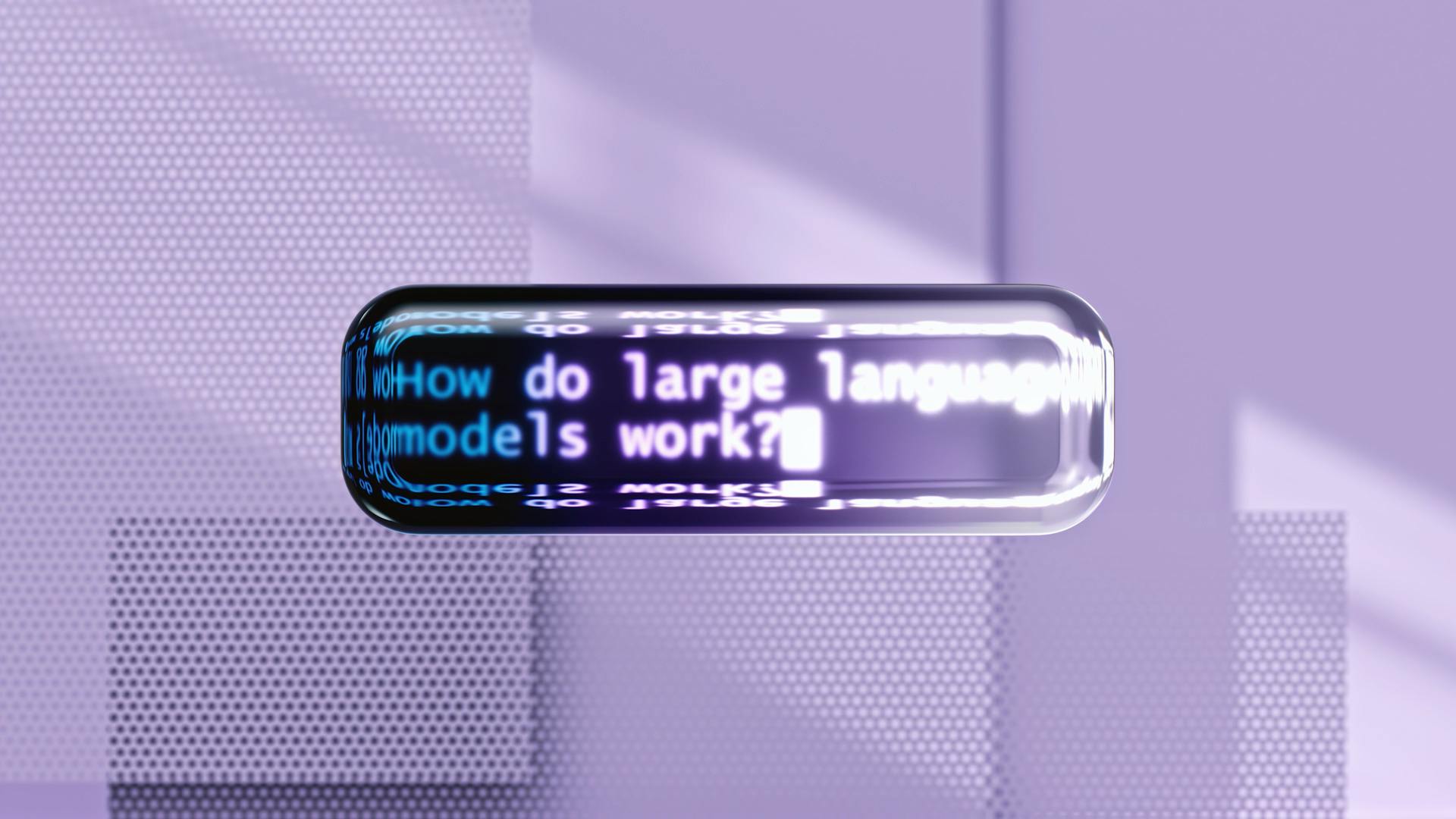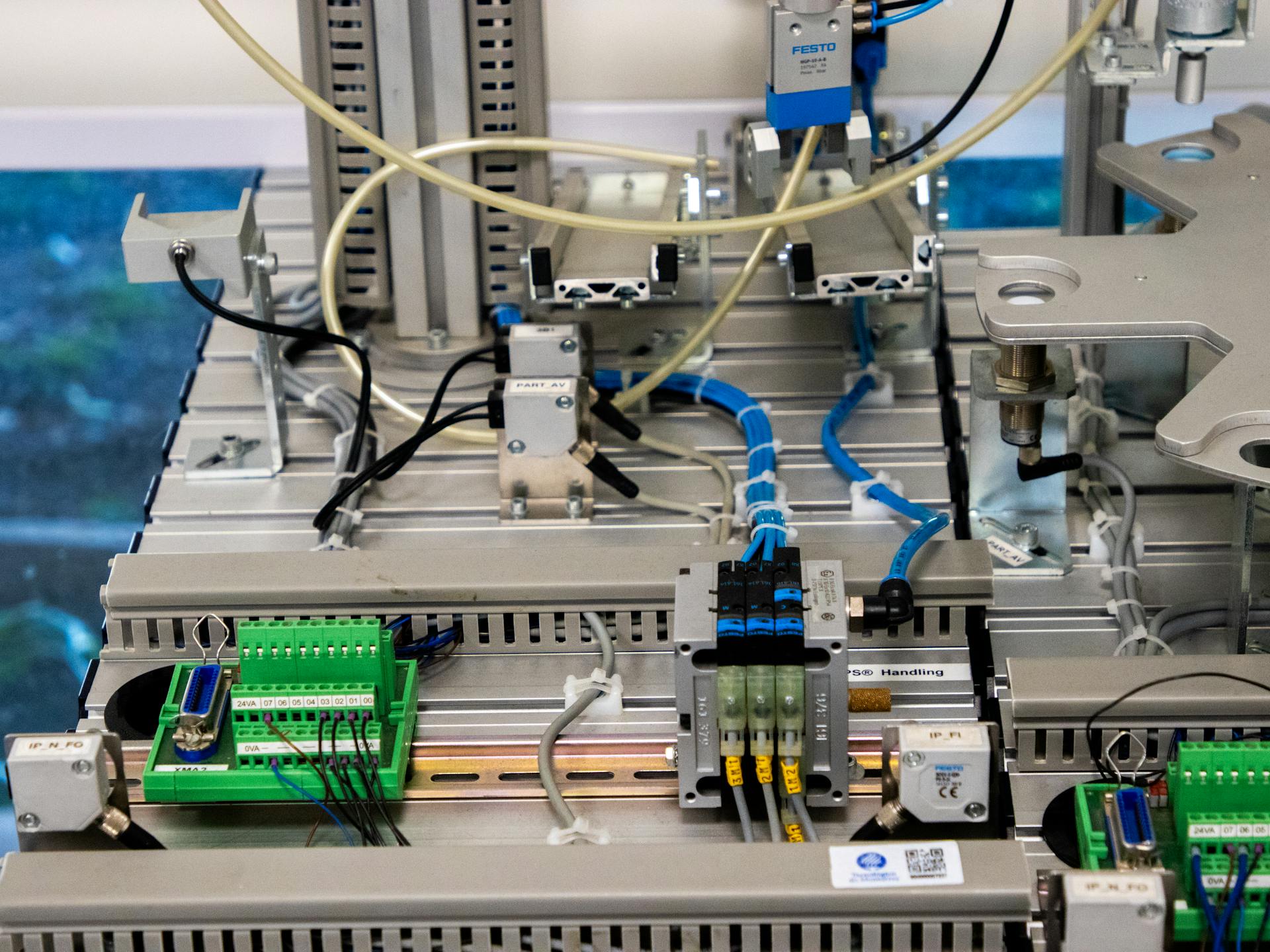
Let's take a look at some examples of electrical generators and their applications. The alternator is a type of electrical generator that converts mechanical energy into electrical energy.
These generators are commonly used in vehicles to charge batteries and power electrical systems. In fact, most cars and trucks have an alternator that generates 13.5 to 14.5 volts of electricity.
A dynamo is another type of electrical generator that produces direct current (DC) electricity. These generators were widely used in the past for powering homes and businesses.
The steam turbine generator is a type of electrical generator that uses steam to drive a turbine, which in turn generates electricity. This type of generator is commonly used in power plants to produce electricity on a large scale.
Here's an interesting read: Generators Create Electrical Energy.
Terminology and Basics
Electrical generators are machines that convert mechanical energy into electrical energy. This process is crucial for powering our homes, schools, and industries.
There are two main types of electrical generators: dynamos and alternators. Dynamos generate pulsing direct current, while alternators produce alternating current.
For more insights, see: How Electrical Generators Work
The key components of an electrical generator include the rotor and stator. The rotor is the rotating part of the machine, while the stator is the stationary part that surrounds the rotor. One of these parts generates a magnetic field, while the other has wire windings that induce an electric current.
The armature is the power-producing component of an electrical machine, and it can be located on either the rotor or the stator. The field, which can be an electromagnet or a permanent magnet, is responsible for generating the magnetic field.
Here's a quick rundown of the main components:
- Rotor: The rotating part of the electrical machine.
- Stator: The stationary part that surrounds the rotor.
- Armature: The power-producing component that can be on either the rotor or stator.
- Field: The magnetic field component that can be an electromagnet or a permanent magnet.
Terminology
Let's break down the terminology surrounding electromagnetic generators. Dynamos and alternators are the two main categories, with dynamos generating pulsing direct current through a commutator and alternators generating alternating current.
Dynamos and alternators have a rotor and a stator, which are the rotating and stationary parts of an electrical machine, respectively. The rotor is the rotating part, while the stator is the stationary part that surrounds the rotor.
On a similar theme: Direct Current Electric Generator

The magnetic field in a generator is produced by either a field winding or a permanent magnet. Field windings are wire windings called field coils that create the magnetic field, while permanent magnets are used in some generators to produce the field flux.
The armature is the power-producing component of an electrical machine, generating the electric current that provides power to an external circuit. In some generators, the armature windings are on the rotor, while in others they are on the stator.
Here's a quick reference guide to help you keep track of the main components:
- Rotor: The rotating part of an electrical machine.
- Stator: The stationary part of an electrical machine.
- Field winding or field (permanent) magnets: The magnetic field-producing component of an electrical machine.
- Armature: The power-producing component of an electrical machine.
It's worth noting that the parts of a dynamo or related equipment can be expressed in either mechanical or electrical terms, which can sometimes lead to confusion.
What Is an Electric?
Electric generators are basically machines that convert mechanical energy into electrical energy.
The mechanical energy is usually provided by steam turbines, gas turbines, and wind turbines.
These generators are responsible for providing nearly all the power that's required for electric power grids.
History of Electrical Generators
Electrostatic generators were used before the connection between magnetism and electricity was discovered. They operated on electrostatic principles, using mechanisms like electrostatic induction or the triboelectric effect to generate high voltage and low current.
These early generators had significant limitations, including difficulty in insulating machines that produced high voltages and low power ratings. As a result, they were never used for generation of commercially significant quantities of electric power.
The first electromagnetic generator, the Faraday disk, was invented in 1831 by British scientist Michael Faraday, marking a significant shift away from electrostatic principles.
For another approach, see: Electrostatic Generator
History
Before the connection between magnetism and electricity was discovered, electrostatic generators were invented. They operated on electrostatic principles, using moving electrically charged belts, plates, and disks to carry charge to a high potential electrode.
Electrostatic generators were used before the relationship between electricity and magnetism was discovered. These generators were never used for generation of commercially significant quantities of electric power due to their inefficiency and difficulty of insulating machines that produced very high voltages.
The Wimshurst machine and the Van de Graaff generator are examples of electrostatic generators that used electrostatic induction or the triboelectric effect to generate charge. The Wimshurst machine used electrostatic induction, while the Van de Graaff generator used either of two mechanisms: charge transferred from a high-voltage electrode or the triboelectric effect using the separation of two insulators.
The first electromagnetic generator, the Faraday disk, was invented in 1831 by British scientist Michael Faraday. This marked a significant shift away from electrostatic generators and towards the development of more efficient and practical electrical generators.
Electrostatic generators had low power ratings and were never used for generation of commercially significant quantities of electric power. Their only practical applications were to power early X-ray tubes and later in some atomic particle accelerators.
Curious to learn more? Check out: Peltier Effect Generator
Jedlik's Dynamo
In 1827, Anyos Jedlik started experimenting with electromagnetic rotating devices which he called electromagnetic self-rotors.
Jedlik's prototype of the single-pole electric starter, finished between 1852 and 1854, used both the stationary and revolving parts as electromagnets.
A unique perspective: Dc Electromagnetic Generator
He formulated the concept of the dynamo at least 6 years before Siemens and Wheatstone.
Jedlik's concept of the dynamo involved using two electromagnets opposite to each other to induce the magnetic field around the rotor.
The stationary and revolving parts of Jedlik's dynamo were both electromagnetic, a design that would later be used in the development of more efficient electrical generators.
Jedlik's work on the dynamo predated the development of the first dynamo based on Faraday's principles, which was built by Hippolyte Pixii in 1832.
Pixii's dynamo used a permanent magnet and a commutator to convert the alternating current to direct current, a design that was also used in Jedlik's prototype.
Types of Electrical Generators
Electric generators come in different types, each producing either direct current (DC) or alternating current (AC). AC generators, also known as single-phase generators, are limited to 25 kW.
DC generators are divided into three categories: shunt, series, and compound-wound. Shunt generators are commonly used in battery chargers, while series generators are used in street lights. Most DC generators are compound-wound.
Here are the main types of electric generators:
Specialized Types of
The Faraday disk generator is a type of homopolar generator that uses a copper disc rotating between the poles of a horseshoe magnet to produce a small DC voltage. It's an early example of an electromagnetic generator.
A homopolar generator, also known as a unipolar generator, can produce tremendous electric current, some more than a million amperes, because the homopolar generator can be made to have very low internal resistance.
Induction generators operate by mechanically turning their rotor faster than the simultaneous speed, giving negative slip. This allows them to recover energy with relatively simple controls.
A power station, also known as a power plant or powerhouse, is an industrial facility that generates electricity using one or more generators. Most power stations contain a stationary structure that generates a strong magnetic field and a set of rotating windings.
The Gramme dynamo is a design that replaced the spinning coil with a toroidal one, smoothing out the current. This design was later improved upon by Zénobe Gramme in the 1870s.
AC generators are limited to 25 kW and are known as single-phase generators.
A different take: Homopolar Motor Generator
Types of Electrical Generators
Electric generators come in different types, and understanding these classifications can help you choose the right one for your needs.
AC generators, also known as single-phase generators, are limited to 25 kW of electrical energy production.
DC generators, on the other hand, are divided into three categories: shunt, series, and compound-wound. Shunt generators are commonly used in battery chargers, while series generators are often used in street lights.
Most DC generators are compound-wound, which offers a balance between shunt and series generators.
Here's a breakdown of the main types of electric generators:
Magnetohydrodynamic (MHD)
Magnetohydrodynamic (MHD) generators directly extract electric power from moving hot gases through a magnetic field, without the use of rotating electromagnetic machinery.
The first practical design was the AVCO Mk. 25, developed in 1965. The U.S. government funded substantial development, culminating in a 25 MW demonstration plant in 1987.
MHD generators operated as a topping cycle are currently less efficient than combined cycle gas turbines.
Check this out: Generator Mhd
Maximum Power
Maximum power is a key concept in electrical generators, and it's determined by the load's resistance. The maximum power theorem states that the maximum power can be obtained from a generator by making the resistance of the load equal to that of the generator.
This means that if a generator is designed to operate at maximum power output, the power transfer efficiency is only 50 percent. Half the power generated is wasted as heat inside the generator.
Low-Power
Low-power generators are used in various small applications, such as powering bicycle lights with 0.5 A permanent-magnet alternators that supply 3-6 W at 6 V or 12 V.
These generators are designed with great precision to achieve high efficiency, but even the best ones have a maximum efficiency of only around 60 percent due to the use of permanent magnets.
In contrast, vehicle alternators can achieve efficiencies of up to 90 percent over a wide speed range by control of the field voltage.
Broaden your view: Permanent Magnet Synchronous Generator
Commercial vehicles often use 24 V to give sufficient power at the starter motor to turn over a large diesel engine without the requirement for unreasonably thick cabling.
Some vehicles have electrically-powered steering assistance and air conditioning, which places a high load on the electrical system, requiring a rated output of 50-100 A at 12 V.
Sailing yachts may use a water or wind powered generator to trickle-charge the batteries, supplying currents of up to 12 A at typical cruising speeds.
Low-Power Generator Outputs:
Genset
A genset, short for generator set, is essentially a self-contained unit that combines an electrical generator and an engine. This setup allows for independent electricity supply, making gensets ideal as backup power sources.
Gensets come in various sizes and types, ranging from small portable petrol-powered sets to large turbine installations. You can even find hybrid diesel-gas units, known as dual-fuel units.
The primary advantage of gensets is their ability to provide a reliable power source, especially during routine power outages. As mentioned in Example 3, a high-capacity standby backup generator can keep you on your daily routine without missing a beat.
Here are some common types of gensets:
Gensets are used extensively in various settings, including construction sites, as mentioned in Example 1, and in power stations, as described in Example 2. They're also used in labs due to their ability to provide a range of voltage output.
Human Powered
Human powered electric generators are a viable option for off-grid energy needs. They can be driven by muscle power, such as pedal power or a foot pump.
These generators are commercially available and have been experimented with by DIY enthusiasts. They can be used to charge batteries and, in some cases, come with an integral inverter.
An average "healthy human" can produce a steady 75 watts of power for eight hours, while a "first class athlete" can produce up to 298 watts. However, this level of power is unsustainable and will exhaust an average person within 10 minutes.
Portable radio receivers with a crank are designed to reduce battery purchase requirements. They were used in the Australian outback during the mid 20th century to provide schooling and other essential services in remote areas.
Intriguing read: Does a Generator Produce Ac or Dc
Frequently Asked Questions
What is the most common electric generator?
The most common type of electric generator is a gasoline generator, ideal for powering lower-powered appliances and tools.
What is a real life example of a generator?
A portable residential generator is a real-life example of a generator, commonly used to power appliances and tools such as refrigerators, pumps, and electrical tools in a yard.
Featured Images: pexels.com


